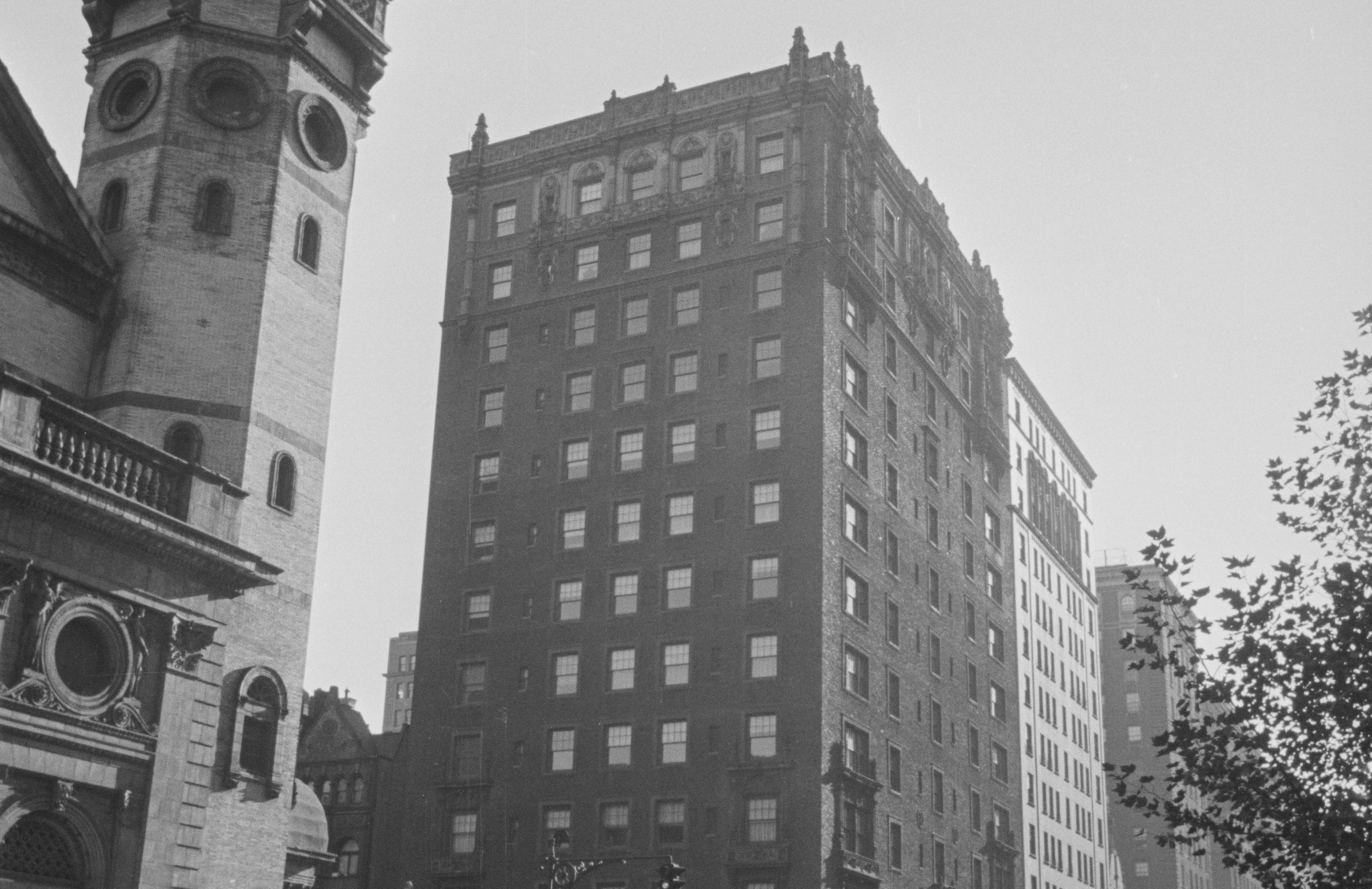
530 West End Avenue
by Tom Miller
On September 16, 1911, the Record & Guide reported that the architectural firm of Mulliken & Moeller “have plans in progress for a twelve-story elevator apartment house to be erected by the Eighty-sixth Street and West End Avenue Company…at 528 to 536 West End avenue.” What the article did not mention was that the principal of that syndicate was one of the architects—Harry Mulliken.
No. 530 West End Avenue was completed in 1912. Its unique Spanish Renaissance details included terra cotta pilasters, friezes, and enframements. A brochure explained, “There are two apartments on a floor, which can be transformed into one single floor apartment.” Each suite (one of which was 17 rooms) included up-to-the-minute amenities like “a kitchen with fixtures especially designed, a ventilated gas range of the most modern type, porcelain sink, wash tray and heavy oak drip board, ventilated steel garbage closet, especially constructed porcelain lined refrigerator.”
The details in the bathrooms were equally impressive. The brochure described, “solid porcelain tubs of Roman type, a porcelain pedestal lavatory, shampoo shower, needle shower and needle bath, gas towel bar, glass shelves, holders, and a large cabinet with mirror over the lavatory.” In the basement, maids would find wash tubs “with steam jets for boiling the clothes, iron boards and drying frames, all operated by steam and electricity.” There were also “drying frames” on the roof for summer months. Rents ranged from $2,800 to $4,400 according to an advertisement on May 31, 1912. The most expensive would translate to about $12,000 a month in 2025.
Each suite (one of which was 17 rooms) included up-to-the-minute amenities…
Edwin Mortimer Barnes and his wife, the former Theresa Chalmers, were initial residents. The couple was married on April 14, 1910, and their daughter, Barbara, was born the following February. Born in 1881, Barnes was the son of Edwin Morris Barnes, the head of the publishing firm A. S. Barnes & Company. His privileged education included preparation at the Englewood Military School, the Halsey School, and Philips-Andover before enrolling at Yale University.
Barnes initially joined his father’s business, then changed course to become a broker with Hollister, Fisk & Company. He additionally held positions in directorships in Brannworth & Company, bookbinders, the Scientific Press, printers, and the Barnes Real Estate Association
The Franklin Petits were also initial residents. Their son Franklin Petit, Jr., who graduated from Cornell University in 1913, was an architect. At the end of 1914, according to the Cornell Alumni News that December, he was working on the construction of “two twelve-story apartment houses.” His parents would remain in the building into the 1920s.
Perhaps the most visible couple, socially wise, were Charles Hathaway and his wife, the former Cora Southworth Rountree. Hathaway was a partner in the brokerage firm Hathaway, Smith, Felds & Co. The couple had four sons, Stewart Southworth, Harrison Rountree, Charles Jr., and Robert W.
Cora Hathaway’s name repeatedly appeared in the social columns for her entertainment. On January 21, 1917, for instance, The Sun reported, “Mrs. Charles Hathaway will give her home, 530 West End avenue, for a card party on Monday afternoon, January 29, the proceeds of which will be devoted to the social service work of the Polyclinic Hospital.” Four months later, on May 21, the New-York Tribune announced, “Mrs. Katharine Johnson Ashe, accompanied by Kyle M. Dunkel, will give a musical recital of ‘Enoch Arden’ on Wednesday evening at the home of Mrs. Charles Hathaway, 530 West End Avenue.”
The unmarried, affluent Beatrice Provost Nugent lived here in 1919. On May 5 that year, she advertised in the New-York Tribune, “Lost—Sable neckpiece, at Plaza Hotel or between there and 530 West End av.” Two years later, Beatrice would have greater things on her mind than a missing sable.
Beatrice’s grandfather, William Van Rensselaer Smith, died, leaving most of his $9 million estate to her grandmother, Roxy M. Smith. Roxy’s will provided that her estate would be divided equally between Beatrice and her uncle, William E. Smith. Unknown to Roxy, William married Clair (sometimes spelled Clare) Staley. The Evening World explained that Mrs. Smith, “had a strong dislike for Miss Staley and to have forbidden [her into] her house.” Afraid he would be disinherited, William persuaded Beatrice to keep the marriage from her mother.
Roxy M. Smith died in the Waldorf-Astoria on August 8, 1921, leaving an estate equal to about $153 million today. Beatrice now discovered that a few days before Roxy Smith died, Clair had persuaded her husband to transfer his inheritance to her. On August 19, 1921, Beatrice obtained an injunction to prevent the woman her grandmother hated from receiving the $4.5 million.
Beatrice would be married before the case was finally resolved. On January 5, 1924, The Pleasantville Press of Pleasantville, New Jersey reported, “Mrs. Beatrice Provist [sic] Trenkham…has won her fight against her uncle, William E. Smith.” Beatrice was now the recipient of her grandmother’s entire, massive fortune.
In the meantime, on March 24, 1920, the New-York Tribune reported that “a syndicate of tenants” had purchased the building. In reporting on the cooperative, The New York Times commented that there were 25 apartments in the building.
Roxy M. Smith died in the Waldorf-Astoria on August 8, 1921, leaving an estate equal to about $153 million today.
Living here at the time were Horatio W. Seymour and his wife, the former Annie E. Jones, who was married in 1876. Born in 1854, Seymour went into the newspaper business as a boy. In 1875, he landed a job as night editor of the Chicago Times. The Greencastle, Indiana Banner & Times noted on December 18, 1920, “His headlines in that newspaper are regarded as the forerunners of the headlines of metropolitan journalism to-day.” In 1908, he became the editorial writer of The World. The 66-year-old was still at the position when he suddenly died in his apartment here on December 17, 1920.
The last of the Hathaway sons, Robert, was married in 1929. The Rochester, New York Times-Union said he “attended Yale University [and] looks not unlike Calvin Coolidge.” His marriage transformed Robert into a monarch. The newspaper explained that his bride “was Seigneur of Serk until her marriage.” The title now transferred to Robert and they became Seigneur and Dame of Serk.
The Island of Serk (sometimes called Sark) was described by the Times-Union as “a minuscule and anachronistic portion of the British Empire, lying midway between France and England in the English Channel.” It had been a feudal state by Queen Elizabeth in 1565, “and it has remained so to the present day, undisturbed by the rise of a parliamentary system in England,” said the article. “The Hathaways still take orders only from the King of England in council.”
On November 6, 1936, the Times-Union headlined an article, “Last Feudal State Rulers Visiting U.S.” While Robert and his wife visited the Hathaways in their apartment here, the “two rulers presented a twentieth century appearance while expounding sixteenth century customs.” Robert said that the government debated like, “Oh, just simple things pertaining to the island. Whether there should be a dog tax. Whether we should allow divorce on the island. That last was thrown out.”
The building, which the coop board christened The Sexton at some point, had its place in the cinematic spotlight in 1984 when it briefly appeared in the motion picture Romancing the Stone. In it the character Joan Wilder, played by Kathleen Turner, lived here.
Tom Miller is a social historian and blogger at https://daytoninmanhattan.blogspot.com/


